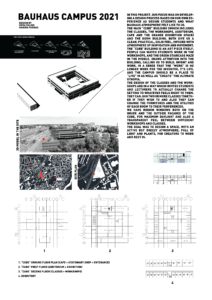Just as Bauhaus adapted to the new needs of society at the beginning of the last century, our proposal seeks to respond to the new challenges we face today.
The new architecture must respond to transcendental issues such as climate change and the scarcity of green areas in urban centers. At the same time, it must be flexible, adapting to different uses and allowing teamwork.
With these aspects in mind, our proposal divides the program into different blocks connected by large green spaces. Due to the proximity of the train tracks, we decided to build a wall, which isolates visually and acoustically, surrounded by a large mass of trees that act as a vegetation barrier. In the northern part of the plot, there is a small forest with winding paths and benches.
The main block contains the most important area of the campus: the exhibition hall. It is located on the top floor, next to the virtual space, which has a conference room that can be broadcasted via streaming and a computer room where a historical archive will be created for consultation via Internet. There is also a cafeteria linked to a terrace. The lower floor has an auditorium and a cafe for the entire campus and is connected to the upper floor by a staircase and two elevators.
A large ramped staircase marks the access to the main block, with a public vocation, as it opens onto the square, being a partially independent place of the campus that can function as an autonomous element with its own differentiated access.
The roofs are green to integrate into the plot and for climatic reasons. They have a composition inspired by the pictorial work of Piet Mondrian.
Throughout the campus there are green areas with benches that allow people to meet and make it an attractive place, even when the university is not in operation.
The residence has two different entrances through which you can access single rooms and common areas on the first floor, or go up to the upper floor where all the double rooms are located. It has capacity for 52 people, with 12 single rooms and 20 double rooms. The common areas of this residence are: a kitchen, a shared space filled with tables and a study room dedicated to students where can enjoy a place to focus on their studies.
The workshop block has a large working area, a plotter classroom, a small photographic studio and a painting area with booths and water outlets. There is also a link to a covered terrace.
The classrooms are divided into small pavilions with benches and trees between them. They are multi-purpose, allowing different compartmentalizations, being able to create several spaces within each classroom or, on the other hand, to join two classrooms. This functional flexibility opens up new possibilities compared to traditional teaching and enhances teamwork.










